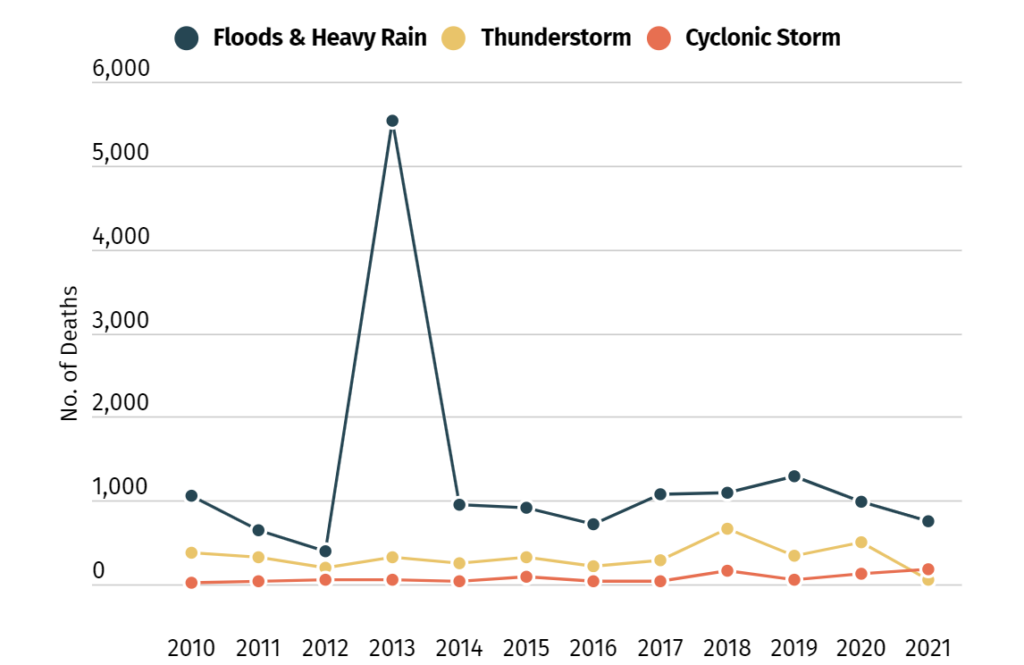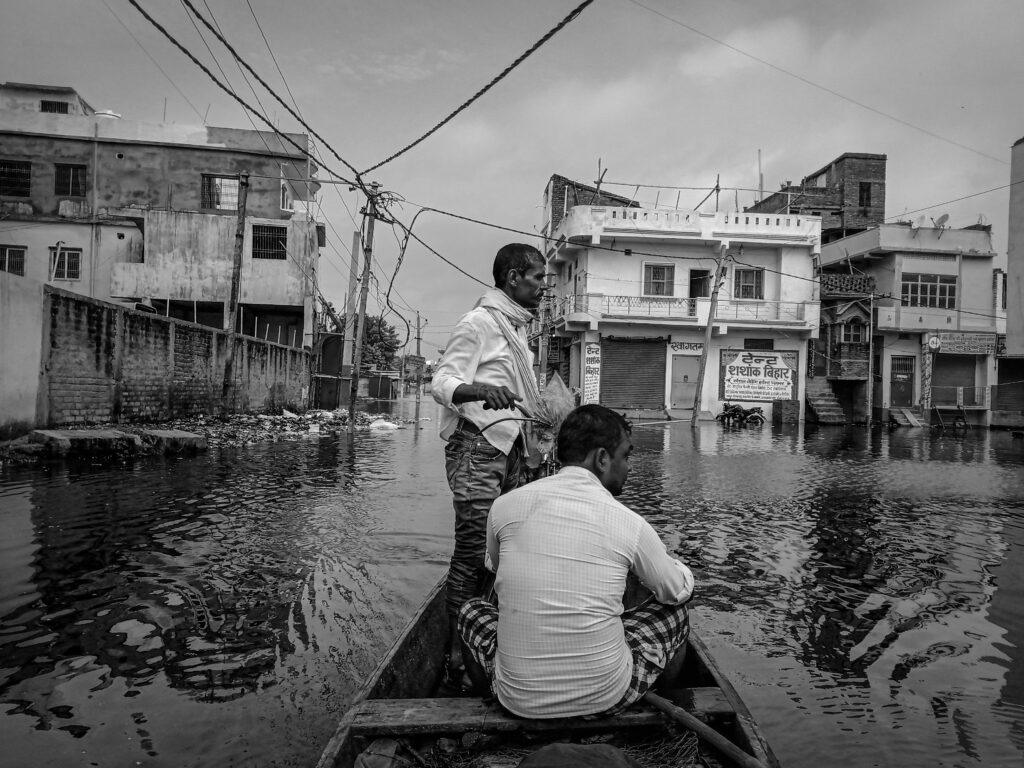The Context
The startling pictures from the recent flash floods in different parts of our country once again bring to fore the issue of extreme climatic changes and its impact on our lives. The increase in global temperatures causes higher frequency of extreme climatic phenomena like floods, heat and drought, as well as long-term shifts such as sea-level rise, ice mass loss in mountain glaciers worldwide, shifts in flower/plant blooming; and extreme weather events.
The climatic situation has reached an irreversible point. The point of no return. Even if the way of life on Earth changes immediately, the damage has been done. Apparently, the consequences of the long-term neglect of environmental protection are no longer avoidable. This gloomy forecast, confirmed by the United Nations Educational, Scientific and Cultural Organization (UNESCO), urges coastal cities to prepare by putting in place the necessary precautions.
The Problem
India is the worst flood affected country in the world after Bangladesh and accounts for one-fifth of global death count due to floods. About 40 million hectares of land in the country is liable to floods.
The unpredictable nature of Monsoon in India catches the villagers unaware when sudden torrential rains and subsequent floods happen.
According to reports from the World Meteorological Organization (2009), approximately 70% of all disasters occurring in the world are related to hydro-meteorological events. The Mediterranean region will have to battle against the water element, and given the extent to which it poses a danger to the cities themselves and their inhabitants, preparations must begin immediately.
Urban drainage systems have become overwhelmed, turning streets into torrents, flooding low-lying structures such as underpasses or tunnels, frequently catching people by surprise, turning cars and basements into deadly traps.
In India, year 2021 did not begin on a happy note. According to the Reuters News Agency, a huge rush of water resulting from the collapse of a Himalayan glacier caused the rupture of a hydroelectric dam in the northern Indian state of Uttarakhand. The flood hit and destroyed two hydropower plants (Rishi Ganga and Dhauli Ganga), leaving at least 140 workers trapped there. Near the Dhauli Ganga hydropower plant is an over 200-metre long tunnel where more than 30 people were stuck. Although, several of them were rescued, some could not be saved. The water splash also destroyed a bridge in the Tapovan area connecting 13 villages.
In such a disaster, it is difficult to judge if and how it could have been prevented. There is no knowledge of how the dam was secured, monitored or how long the process that resulted in the dam rupture had lasted. Hence we have to look at ways to minimize the impact of the disaster.
Flood wreaking havoc in towns and villages
Year 2022 monsoons brought with it devastating floods in Assam and other parts of northeast India, and with climate change exacerbating extreme weather events.
By June 22, 88 people had died in Assam and 35 were missing in the floods that have impacted 34 districts. Over 400,000 were sheltering in camps; nearly 125,000 houses were damaged, and 67,290 animals had died, data from the Disaster Management Division of the Ministry of Home Affairs says.

In the past years, Heavy rain have triggered floods in a number of regions including Bihar, Assam, Arunachal Pradesh and parts of Meghalaya; Mumbai, Konkan and Karnataka; and flash floods in parts of Rajasthan.
Spurts of exceptionally heavy rain have paralyzed life in Kerala’s Idukki, where a landslide killed at least 55 people. According to a flood situation report by the ministry of home affairs’ disaster management division, in year 2020, 868 people have lost their lives to floods in 11 states, compared with 908 deaths in the same period last year.
While minimizing the greenhouse emissions to fight climate change is clearly a matter of utmost importance, it is an illusion to believe that the increase in extreme weather that we are already experiencing can be reversed by more ambitious climate action. The scale of the recent disasters is a reminder that adaptation to climate risks is as important as reducing greenhouse gas emissions. There is clearly no direct solution; our alertness, response and recovery – in short, our resilience – to new technologies and adaptation to these new risk levels will only help us.
Plan Z seems to be the only one
Plans A to Y should have been made at a time when these anticipated events could still have been avoided. Today, however, Plan Z will have to be the only effective. The challenge for the territories included in the program is to develop a plan to reduce the potential risk of storm surges by 2030. This should also include the identification of locations at risk, together with the publication of relevant maps.
The Solution – Flood Early Warning System (FLEWS)/ EWS
“The set of capacities needed to generate and disseminate timely and meaningful warning information to enable individuals, communities and organizations threatened by a hazard to prepare and to act appropriately and
in sufficient time to reduce the possibility of harm or loss” (UNISDR,2009)
As the name indicates, Flood Early Warning System (FLEWS) is a system by which flood induced hazards can be minimized and prevented.
Due to technological advances in Electronic Engineering and Communication Technology, effective risk management for flash flood disasters is now achievable through spatial data analysis, and weather prediction.
Early warning systems as part of the plan
What does it all mean? It is more complicated than it may seem, and the preparations that generally take time will have to be made in a fraction of that time, or to be done in advance. Early warning systems are only a fraction of the equation, the outcome of which is to help reduce the negative impact.
The paradigm for disaster risk management has to be broadened from simply post-disaster response to a more comprehensive approach that also includes prevention and preparedness measures.
Under the Hyogo Framework for Action, 2005-2015 (which was adapted by 168 countries), it was decided to enhance enhancing early warning systems. Since then, efforts have been underway to incorporate early warning systems as an integral component of any nation’s disaster risk management strategy, enabling governments and communities to take appropriate measures towards building community resilience to natural disasters. EWS/ FLEWS are increasingly recognized at the highest political level as a critical tool for the saving of lives and livelihoods, and there are increasingly more investments by national and local governments, international development agencies, and bilateral donors to support such systems.
The Indian government has modern, sophisticated early warning systems for floods and cyclones. The need of the hour is impact-based forecasts that identify risks, quick dissemination of information to people, availability of scientific data on the effectiveness of warning systems and localized action plans to follow warnings.
Why Flood Early Warning System is must?
- It is relatively low-cost approaches compared to structural measures such as dikes and dams include flash flood forecasting and early warning systems.
- For flash floods, there is only a short time available for warning, preparation and response.
- Provides real-time data acquisition and transmission.
- Provides public alert notifications for flash flood situations such as intense rainfall causing lake formation in catchment area.
- Trend analysis to identify lake formation or steep rise in water level due to heavy rainfall.
Tips to mitigate flash flood disaster
- Preparing Flash flood and surface water maps for the entire country. Many areas, especially those far away from rivers or the sea, appear to be safe from flooding but can quickly flood during extreme rainfall events. Making those maps available and easily accessible can help people identify their risk and prepare for the worst.
- Identification of high risk and vulnerable areas for installation of FLEWS.
- Use of advancement in technology for development planning of government. Advancement in communication technology, spatial data analysis and weather prediction which will lead to effective forecast of flood timing and magnitude of flood peaks.
- Provisioning of resilient and industry hardened FLEWS with adequate power backup (to operate on consecutive cloudy and rainy days) and wide operating temperature range.
- Provisioning of resilient & redundant digital and communication infrastructure (such as GPRS, VSAT & RF) to effectively relay warning in-case of network outages during flash flood event.
- Use of Artificial intelligence to monitor trends and give predictive warnings.
- Provisioning of effective alert dissemination system via Siren, Text and audio messages, in downstream and populated areas.
- Raising public awareness of flood risk should be prioritized in areas susceptible to flash flooding, and in regions with low incidence of serious flooding. Warnings need to be accessible and actionable with clear advice on how to respond.
- Regular ‘climate checks’ of critical infrastructure and older buildings. Most buildings and critical infrastructure have not been designed with increasing impacts from climate change in mind.
- Improve absorption capacity through ‘sponge cities’ with blue-green infrastructure and changes in land-use practices in agriculture and forestry. The more rainfall that can be absorbed, the less water ends up in rivers or in urban drainage systems, causing floods.
Role of M2MLogger
In the several process steps of Early warning systems, we come in for Monitoring and Warning systems, and Dissemination and Communication devices.
Continuous monitoring of hazard parameters and contributing factors is essential to generate accurate warnings in a timely fashion.
A flood warning system and a Dam warning systems designed and developed by M2MLogger, help in mitigating the consequences in an emergency. Building a reliable mass warning system is crucial in areas prone to flash floods and landslides. A monitoring system connected to sensors will help in alerting the population to the impending danger. And given that the catastrophe had been unpreventable due to its rapid course, our company’s system can warn of a torrential tidal surge of water, giving the people in danger time to respond, which usually makes a slight difference between life and death. The investment that will buy a customer such a warning system is low compared to any potential damage incurred.
M2MLogger is actively installing Flood Early Warning and Discharge measurement solutions in Indian Himalayas. These systems are highly effective and give accurate results in extreme weather conditions.
If you are planning to install similar solution then our expert team will be glad to assist you.



